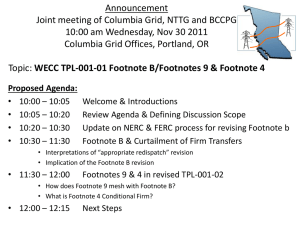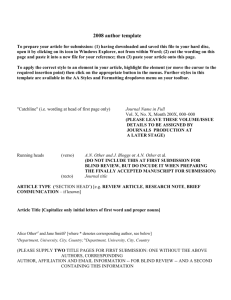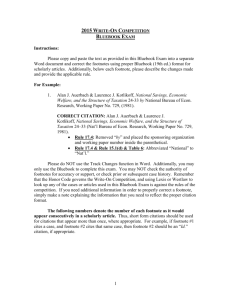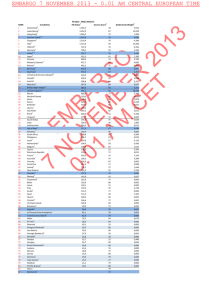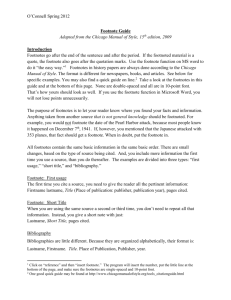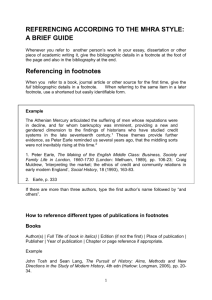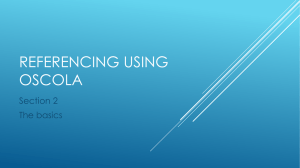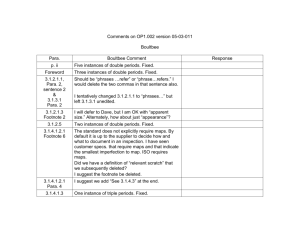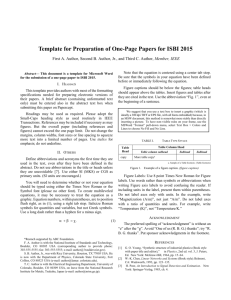Project YYYY-##.# - Project Name
advertisement
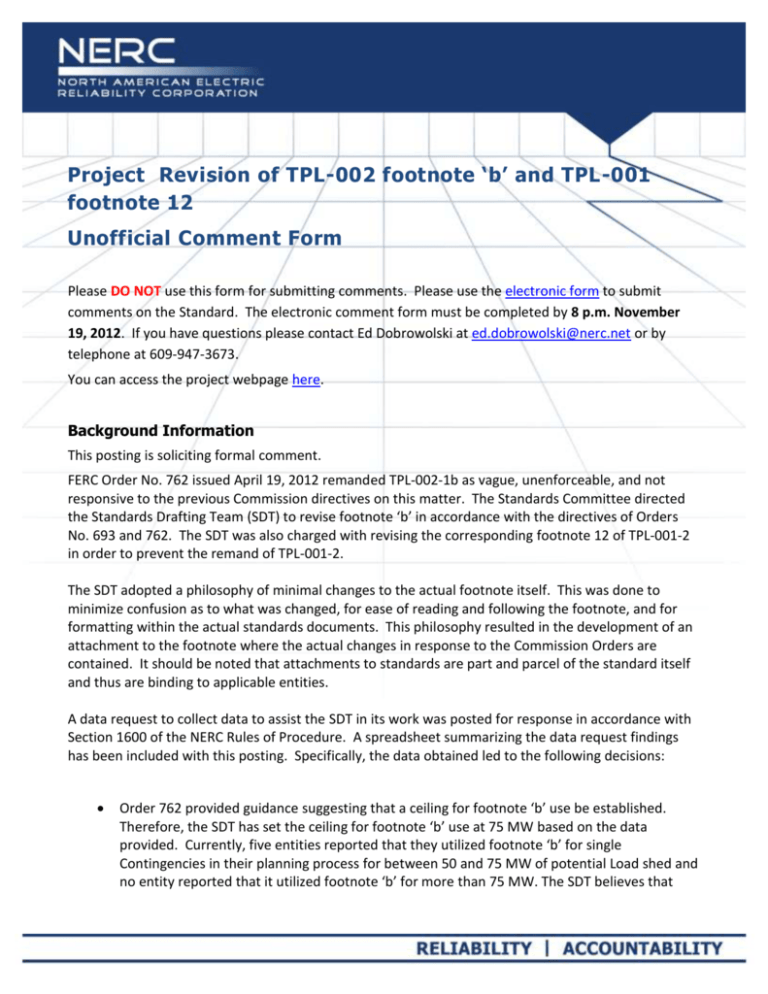
Project Revision of TPL-002 footnote ‘b’ and TPL-001 footnote 12 Unofficial Comment Form Please DO NOT use this form for submitting comments. Please use the electronic form to submit comments on the Standard. The electronic comment form must be completed by 8 p.m. November 19, 2012. If you have questions please contact Ed Dobrowolski at ed.dobrowolski@nerc.net or by telephone at 609-947-3673. You can access the project webpage here. Background Information This posting is soliciting formal comment. FERC Order No. 762 issued April 19, 2012 remanded TPL-002-1b as vague, unenforceable, and not responsive to the previous Commission directives on this matter. The Standards Committee directed the Standards Drafting Team (SDT) to revise footnote ‘b’ in accordance with the directives of Orders No. 693 and 762. The SDT was also charged with revising the corresponding footnote 12 of TPL-001-2 in order to prevent the remand of TPL-001-2. The SDT adopted a philosophy of minimal changes to the actual footnote itself. This was done to minimize confusion as to what was changed, for ease of reading and following the footnote, and for formatting within the actual standards documents. This philosophy resulted in the development of an attachment to the footnote where the actual changes in response to the Commission Orders are contained. It should be noted that attachments to standards are part and parcel of the standard itself and thus are binding to applicable entities. A data request to collect data to assist the SDT in its work was posted for response in accordance with Section 1600 of the NERC Rules of Procedure. A spreadsheet summarizing the data request findings has been included with this posting. Specifically, the data obtained led to the following decisions: Order 762 provided guidance suggesting that a ceiling for footnote ‘b’ use be established. Therefore, the SDT has set the ceiling for footnote ‘b’ use at 75 MW based on the data provided. Currently, five entities reported that they utilized footnote ‘b’ for single Contingencies in their planning process for between 50 and 75 MW of potential Load shed and no entity reported that it utilized footnote ‘b’ for more than 75 MW. The SDT believes that with the Stakeholder Process, the involvement of local regulatory and governmental bodies and by setting a ceiling value for the first time, that it has significantly raised the bar on this issue. Furthermore, the SDT does not believe that it is appropriate to set a limit that would automatically eliminate some existing usages and force those entities to construct new transmission facilities. As shown in the data request findings, the average number of MW used with footnote ‘b’ is approximately 19 MW. The SDT has set the threshold value for when regulatory review is required at 25 MW based on this average value. The SDT believes that setting this value as indicated by the data request findings sets the appropriate balance between the stakeholder process and the additional step of obtaining regulatory and ERO reviews. And again, the SDT believes that setting this threshold value so that regulatory and ERO reviews are required for instances of footnote ‘b’ utilization between 25 and 75 MW significantly raises the bar. The data request showed that the majority of footnote ‘b’ utilizations were at voltage levels below 300 kV. The SDT believes that this validates the selection of the 300 kV EHV distinction in Section III of the Attachment where regulatory and ERO reviews are required. The majority of Contingencies cited as causing an entity to utilize footnote ‘b’ were line outages. This caused the SDT to consider limiting the use of footnote ‘b’ to such types of Contingencies and eliminating its usage for transformer outages. However, with the number of instances of transformer outages reported (11), the SDT did not believe such a step was warranted and has not set up a constraint as to types of Contingencies in association with footnote ‘b’ utilization. The data obtained did not indicate any way to isolate usage of footnote ‘b’ to the fringes of the system whether that meant geographical or electrical fringes. The SDT believes that constraining the use of footnote ‘b’ to the supposed fringes of a system could potentially be discriminatory and thus invalid. In addition, the introduction of the Stakeholder Process for all uses of footnote ‘b’ and the regulatory and ERO reviews for the 25 – 75 MW range of use will allow for a true indication of whether the use of footnote ‘b’ is infringing on societal values which should be a better arbiter of what constitutes a fringe of the system. The SDT has made a number of changes to the Attachment based on comments received from the first posting. Principal among these, was the deletion of the role of the Regional Entity in the review process and the clarification of the role of the regulatory authorities from approval to review. The SDT reminds commenters that the Stakeholder Process was previously approved by the NERC Board of Trustees and that inclusion of this process is not the issue. The issue is clarifying the details of that process to answer the concerns in Order 762. There have been no changes to the Implementation Plan originally filed with the standards. Unofficial Comment Form – Project 2010-11 2 You do not have to answer all questions. Enter All Comments in Simple Text Format. Bullets, numbers, and special formatting will not be retained. Insert a “check” mark in the appropriate boxes by double-clicking the gray areas. Questions 1. Do you agree with the text in the body of the footnote including the maximum capacity threshold? If you do not support these changes or you agree in general but feel that alternative language would be more appropriate, please provide specific suggestions in your comments. For the maximum capacity item, please supply any technical rationale for your comment along with limiting conditions and any current criteria in use at your entity. Yes No Comments: 2. Do you agree with the description and components of the the Stakeholder Process in Section I of Attachment 1? If you do not support these changes or you agree in general but feel that alternative language would be more appropriate, please provide specific suggestions in your comments. Yes No Comments: 3. Do you agree with the Information for Inclusion in the Stakeholder Process contained in Section II of Attachment1? If you do not support these changes or you agree in general but feel that alternative language would be more appropriate, please provide specific suggestions in your comments. Yes No Comments: Unofficial Comment Form – Project 2010-11 3 4. Do you agree with the text in Section III of Attachment 1? If you do not support these changes or you agree in general but feel that alternative language would be more appropriate, please provide specific suggestions in your comments. Yes No Comments: 5. If you have any other comments on this Standard that you haven’t already mentioned above, please provide them here: Comments: Unofficial Comment Form – Project 2010-11 4
